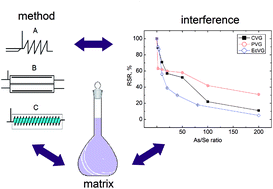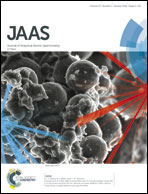Comparison of interference in chemical, electrochemical and UV-photochemical generation methods of volatile Se species
Abstract
We present a comparison of interference in three methods of generation of volatile Se species to compare their performance with regard to matrix effects. The effects of selected hydride forming elements, transition metals and electrolytes are quantified and the similarities and differences between the techniques are compared for individual interferents. The possibility that Co(II), Cr(III) and Ni(II) could be used to increase the response in UV-photochemical generation of volatile Se species is discussed. It was found that the increased sensitivity in the presence of Ni(II) is not due to the increased efficiency of generation but due to processes in the gaseous phase. In general, increased Se signals resulting from modified reactions were associated with alternative vapour generation methods. Electrochemical vapour generation suffers from permanent interference effects located on the cathode, but these were not observed with chemical and UV-photochemical vapour generation. Sb(III) interfered more severely than As(III) irrespective of the method used.



 Please wait while we load your content...
Please wait while we load your content...